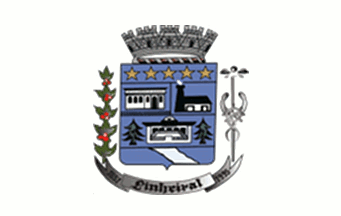 image located by Dirk Schönberger,
26 October 2011
image located by Dirk Schönberger,
26 October 2011Source: http://pt.wikipedia.org/wiki/Pinheiral

Last modified: 2012-04-07 by ian macdonald
Keywords: rio de janeiro | pinheiral |
Links: FOTW homepage |
search |
disclaimer and copyright |
write us |
mirrors
 image located by Dirk Schönberger,
26 October 2011
image located by Dirk Schönberger,
26 October 2011
Source:
http://pt.wikipedia.org/wiki/Pinheiral
Official website at
http://www.prefeiturapinheiral.com.br. On the official site is shown a
description of flag and coat of arms at
http://www.prefeiturapinheiral.com.br/index.php?exibir=secoes&ID=57.
Dirk Schönberger, 26 October 2011
The municipality of Pinheiral (22,724 inhabitants in 2010; 77 sq. km) is located in southern Rio de Janeiro State, 120 km of Rio de Janeiro. Together with Volta Redonda and Barra Mansa, Pinheiral forms a single urban unit with more than 450,000 inhabitants.
Pinheiral originates in the São José do Pinheiro estate, built in 1851
for Commander José Joaquim de Souza Breves (1804-1889), the first
"coffee king" in Brazil. Born in Piraí, Breves was the biggest owner
of land and slaves (more than 6,000) in Imperial Brazil; he
accumulated a huge fortune after purchasing and inheriting several
estates and, mostly, following his marriage with his niece Maria
Isabel de Moraes Breves, the daughter of the Baron of Piraí. His
accounts, published in 1891, included more than 100 properties, 72
estates, buildings in different towns, islands and ships. Breves did
not care of the prohibition of slave' traffic issued in 1850; sued in
1852, together with Manoel de Aguiar Vallim, another "coffee king", in
the "Bracuí case" for the illegal landing of African slaves in Bracuí,
he was eventually acquitted. Breves was a familiar of the Imperial
Court. Aged 18, he witnessed in Ipiranga the proclamation of the
independence of Brazil by Prince Peter on 7 September 1822; the last
living participant to the event, Breves used to remember that the
prince was in a bad mood because of the "feijoado" he had eaten the
evening before. On 15 August 1830, Breves was made Commander of the
Order of the Rose an started a political career, supporting Peter I
until his abdication and opposing to the next governments. Breves was
one of the leaders of the liberal uprising that broke out in Rio de
Janeiro against the conservative government.
In 1870 Breves ceded a piece of land for the building of the Peter II
Railways, renamed the Brazil Central Railways after the proclamation
of the Republic. The station of Pinheiro was established next year;
the Pinheiro-Barra Mansa line was inaugurated by Princess Isabel and
her husband, the Count of Eu. In 1879, Breves died without heir and
his goods were transferred to the Federal State; in 1897, the old
Pinheiro estate was transformed in barracks for the 2nd Chasseurs
Battalion. In 1909, the Zootechnics Federal Station of Pinheiro was
set up, where Hector Raquet, Professor at the State Agricultural
Institute in Gembloux (Belgium), introduced bovines of the Schwyz
breed to increase dairy production; the Station was also used as a
college where the first Brazilian veterinarians were taught. The
Station was visited in 1920 by King of the Belgians Albert I and Queen
Elisabeth, invited by Epitácio Pessoa, President of the Republic of
Brazil.
The district and station of Pinheiro were renamed Pinheiral in 1940,
to prevent confusion with an other town of Pinheiro also located in
the Rio de Janeiro State. In 1953, some local politicians asked for
the transfer of Pinheiral from Piraí to Volta Redonda, to no avail.
The municipality of Pinheiral was established by State Law No. 2,408
of 13 June 1995, approving Bill No. 2,055 of 23 May 1995.
http://www.revistadehistoria.com.br/secao/retrato/o-imperador-do-cafe
- Biography of Commander Breves, by Aloysio Clemente Breves Beiler
The coat of arms of Pinheiral shows, from top to bottom:
- a chief azure charged with five stars or, representing progress;
- a fess divided per pale, dexter, azure the Pinheiral railway station
proper, which contributed to the development of the town, sinister,
azure an oil mill proper, representing a significant source of income
for the town;
- a fess azure charged with the São José do Pinheiro estate proper
surrounded by two araucarias ("pinheiros") vert, representing the
establishment of the "vila" of Pinheiral by José Joaquim de Souza
Breves, a member of one of the most important "Coffee Barons" families;
- a fess azure charge with a bend argent representing river Rio
Paraíba do Sul, of which depended all the economic development of the
municipality.
The shield is surrounded dexter by a branch of coffee proper,
representing the main crop at the time of the "Coffee Barons" and
sinister by symbols argent of economy and commerce.
The shield is surmounted by a mural crown argent representing the
municipal emancipation.
Below the shield a scroll is inscribed "1851 Pinheiral 1995", the
dates being the years of establishment of the Pinheiro estate and of
the municipality, respectively.
http://www.prefeiturapinheiral.com.br/brasao.asp
Ivan Sache, 14 March 2012